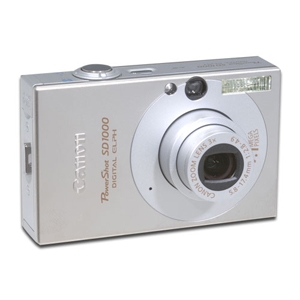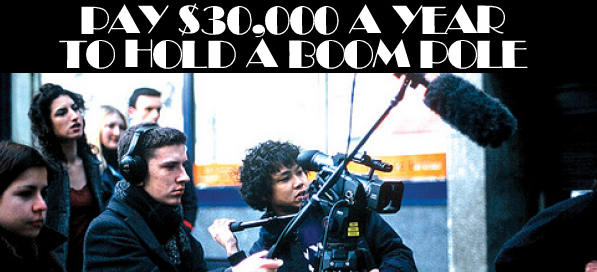MacGyver Filmmaking: An Exercise to Stimulate Your Imagination
It seems like every day a new technical innovation impacts the world of filmmaking. The cameras keep getting better, the software keeps getting faster, the CGI keeps getting more realistic.
New toys are great, but sometimes they can make you lose sight of the essence of telling a visual story. To that end, there’s a fun filmmaking exercise I came up with to keep my wits sharp.
I call it “MacGyver filmmaking”. It’s an exercise in limitations. Here are the rules:
- You have 2 hour to write and plan, 3 hours to shoot a 1 to 3 minute video, and 4 hours to edi
- You can only use your immediate surroundings and objects nearby
- No lighting, no external sound recording , no CGI
- Grab whoever is nearby to act
- You have to use an old school digital still camera with a video function. Like this:

So we’re talking about a quick quick quick, no frills, bare boned production. The opportunity is to take all the energy you might have put into worrying about sound, lighting, fx, and everything other than what is right in the frame and simply focus on the story and the editing. The challenge is how to tell your story with such limitations, and that is where the fun happens.
For writer/directors this is a great way to prepare for the challenges of film set. It also frees you up to forget about logistics and the technical side of filmmaking and just make something up and shoot the darn thing!
A similar approach is used in the 48 Hour Film Festival. Those are a lot of fun, but you still have to assemble a team, grab equipment, light everything etc. This exercise can literally be done with one other person, or even just yourself!
As an example, I made my own MacGyver Short and put it up on Youtube. I decided to make it about my website “Film School Secrets” (which some of you know is about what to do instead of film school). I had my little digital camera, my suit, my diploma, a crucifix, a brick, and a kitten. That’s it.
I storyboarded the script in my mind in about an hour. I didn’t have a tripod so I had to balance the camera using a wooden board. I also didn’t use any sound or lighting, and I edited the darn thing in Windows Movie Maker. (Note: You do not have to subject yourself to using Windows Movie Maker. That is torture).
You can see mine here. These shorts aren’t supposed to look fantastic; it’s the speed and innovation that counts. I managed to get some cool special effects and action with no actors no lights, practically no script, and no crew.
This was mad fun. I was acting and shooting, and my challenge to myself was “How do I make it look like the diploma is attacking me without using any special effects?” So I got some shots of the diploma flying at the camera and basically faked a whole fight scene, adding in the “Terminator 2 music” for impact.
I also found a cheap voice software online and used it to make the robot sound of diploma. I froze right before I wanted to make the kitten and crucifix disappear and had my roommate lift them out of the frame, then spliced the frames together.
To make it look like the diploma was choking me I found a lumbar support pillow from my car and wrapped it around the diploma, then grabbed the back of the pillow and put it around my neck and struggled.
The exercise actually gets more fun the less stuff you give yourself to work with. So take a break from all the high tech toys, and spend a day doing it MacGyver style! Your audience will thank you for it someday.
Beware of Any New York Film School
Here’s a formula for making a lot of quick cash: open a New York Film School. All you need to do is give your school a name with the word “New York” in it, such as ***Academy or New York University. Buy a couple of crappy digital cameras, some boom poles, and then start advertising to young people who don’t know any better.

Clueless Film students pay an arm and a leg to use equipment they could have rented for a couple hundred bucks
Most people looking for “New York Film School” on the internet are probably thinking of the New York Film Academy. These guys are brilliant marketers. They saw that students at NYU Film School were shelling out $30,000 to make silly little films and thought “We could make a lot of money off this.”
The Only Good Thing About a New York Film School Is New York City
New York Film Academy and NYU capitalize on the splendor and excitement of New York City. It’s such a great place to be, people come from all over the world to visit. So setting up a school in the middle of Manhattan automatically makes people excited about going.
But at the end of the day, everyone in the industry knows that these any New York film school is a joke. The cameras are banged up and passed around between hundreds of other students. Courses at NYU cost $42,000 a year. Workshops at New York Film Academy can cost $8,000 for a few weeks to $18,000 a semester. And what are students learning at a New York Film School?
The same things most people learn in their high school’s AV class. How to do little film exercises and make short videos, using video cameras that could be rented for only a few hundreds dollars a day or even purchased for much less than the classes.
People in the industry refer to New York Film Schools as “chop shops” or “diploma mills”. A bunch of starry eyed students are herded up and handed out some cheap equipment, taught some basic filmmaking nonsense. They get excited that they are in a big city shooting little movies. At the end of the day these poor suckers have just paid $30,000 to hold a boom pole. Something that smarter people, people with real careers in the film business, do for free without paying any tuition at all.
Don’t Be Suckered By a New York Film School
Before wasting your time and money on a New York Film School, check out this article on how to reproduce a $42,000 student film for just a few hundreds bucks. You can easily and inexpensively re-create the basic and ridiculously simple exercises that they have you do at either of these New York Film Schools.
And if you want some real world, no bullshit advice on what to do instead of becoming a joke by attending an expensive New York Film School, then make sure to check out Film School Secrets.
98% of Film School Grads Regret Going
 I was at a premier party in Hollywood for a friend’s sitcom pilot last week. This guy is incredible, for the last 2 years he’s been hustling in LA trying to make it as an actor but wasn’t getting any parts he liked. So he went ahead and produced his own sitcom, 1 camera style. And in a packed theater, including many industry peeps, it just killed. Very funny stuff, and he even had some guest stars who have been in movies like “Superbad”.
I was at a premier party in Hollywood for a friend’s sitcom pilot last week. This guy is incredible, for the last 2 years he’s been hustling in LA trying to make it as an actor but wasn’t getting any parts he liked. So he went ahead and produced his own sitcom, 1 camera style. And in a packed theater, including many industry peeps, it just killed. Very funny stuff, and he even had some guest stars who have been in movies like “Superbad”.
Anyway, while there I met this Producer/VP of Acquisitions of a boutique company here in town. She also runs an indie film festival downtown. Like most working professionals in LA, she never went to film school. Instead, she moved to LA and started hustling, taking work one very project she could find. Eventually she found her calling (Producing) and built up a solid network of collaborators.
We chatted about film school and it was hysterical. She told me that at the last festival she asked the filmmakers in the audience “How many of you guys have gone to film school?” She said almost everyone raised their hands. Then she asked “If you knew then what you know now about the film business, how many of you would go back?
Out of all the people present, only about 2 raised their hands. Seriously.
This isn’t an isolated incident. It’s everywhere, in every city and country where people make movies. I even received a comment on another blog post recently from Evan Luzi, Assistant Cameraman and creator of theblackandblue.com. ”The number of times I hear on set that someone went to film school but felt like they hadn’t learned anything when they actually started working in the industry is staggering.”
Why do film school grads end up regretting their choice?
The main reason is that working on student films is nothing like working on a real film. It’s like pre-school versus high school. Things move slowly and many amateur silly mistakes are made, like the blind leading the blind. If you want to learn the right way, get yourself onto a real film set and learn from people who have been making movies for more than a semester.
Many students are shocked to find that everywhere from NYU to USC to NYFA requires students to pay for their student films ON TOP OF tuition. You’re also competing with hundreds of other students for access to equipment. Meanwhile, the people that skip film school, but their own equipment, and get on real film sets end up making more projects, more connections, and learning more than their counterparts sitting in a classroom, listening to lectures from professors who aren’t even working in the industry.
Additionally, the staggering cost of film school ends up following many grads through the rest of their lives. Which is sad, considering that getting on a film set is something you can do for free, and the skills of filmmaking are simple and intuitive. The average starting salary for an NYU or NYFA graduate is horrifying, well below $25,000 a year if you are being generous. NYU doesn’t provide job placement stats. To see sample job placement stats click here.
My friend who shot that pilot, and is currently being wooed by agents and other powerful people in the biz, did not attend film school. In fact, his brother attended AFI and talked him out of gong to film school. Thank goodness, if he had gone, who knows where he would be today?
Don’t become another regretful statistic. Before wasting your precious time and money on film school, check out Film School Secrets to learn what to do instead.
Is This Really What a $40,000 Film School Film Looks Like?
NYU and USC are considered to be the most prestigious film schools in the entire country, if not the world. At $42,000 a year in tuition alone, its costly to be a student at one of these film schools. What specific instructions are students receiving at these schools, and what are they producing? Most people are floored when they find out.
Let’s begin at the beginning. The two share a very similar curriculum and approach to teaching young filmmakers about the craft. After a full year of non filmmaking NYU students take a course called “Sight and Sound: Film”. USC Students take a course called “310″. The courses are virtually the same, and have been copied by New York Film Academy and any other school that still offers film based filmmaking.
The main ingredients are an Arri-S camera (or Bolex) and 16mm black and white reversal film. Reversal film is cheap, like slide film, in that the film that goes inside the camera is the film that actually gets developed and printed. There is no negative.
Students are taught how to load their cameras and use a light meter in about an hour. They are then sent out to their city/campus and told to shoot a variety of “exercises”. Several of the films are silent, with no sound allowed. The latter films allow “non synch” sound. Here are some examples. This is a Sight and Sound Film from NYU:
and this a film from class 310 at USC:
And this is a similar one from New York Film Academy’s $18,000 a semester course:
And that’s how to make a $40,000 short film in black and white: by going to film school.
If you’d like to make an old school film without taking out a loan, here’s how.
First off, know that the Arri-S is not manufactured anymore. Its debut as a cutting edge technology was back around 1960, and hasn’t been used in the film industry since then. It’s only users are… film students. Like these.

Film schools have bought out most of the remaining supply of cameras to give to their students. But, in New York City or LA you can rent one elsewhere for about $150 a day. You can go to Brooklyn and check out Hit and Run Productions.

Google ”16mm reversal film”. Buy a roll, and you can rent a light meter for $10 and some lights for under $50. Ask the guys at the production house how to use the light meter and load the film. Go out, shoot your film, and then go to colorlab.com to have it developed and put on a mini-DV tape. Edit it on your home computer. Done.
Of course, if you’d like to start making movies with color and sound, you might want to buy an HD camera, get Final Cut, and learn about After Effects. You will miss out on whatever artistic lessons a film student gets by spending a year’s salary making black and white movies with no sound. But then again, you may just make something people actually want to watch. For more insight check out Film School Secrets.
$40,000 to Learn What a C47 Is?
If you’re applying to film school, be prepared to wrap your brain around some obscure, technical terms unbeknown to most laypeople. Just like a doctor, civil engineer, or rocket scientist, you are paying for a high quality and in depth education on processes, systems, and technologies that would elude almost anyone else who has not received such training.
The first such term, I will reveal to you, is something almost nobody outside of the film business or film school is aware of. And that term is, a C47. Yes, a C47 is one of the most important and commonly used terms on a film set. This complex, cutting edge piece of equipment is something that every aspiring filmmaker should know about, and something we can only begin to scratch the surface of in this blog post. For truly comprehensive C47 training, make sure to apply to a school like New York Film Academy, NYU, or USC.
There you will receive proper guidance on how to use a C47, the subtle nuances, the history of this powerful tool. Your thousands of tuition dollars will be spent wisely garnering every tidbit of juicy information you can gather about this elusive subject.
By now, you may be wondering: what exactly is this mysterious “C47″? And why haven’t I heard of it before? Do I need to go to film school to unearth the wonders of this marvel of high tech gadgetry?
Yes, yes you do. Because only a skilled and experienced Professor of Film and Video Production can adequately train you for the intense, rigorous, and challenging use of a C47.
So go, quickly, and apply for film school, or you may be left behind.
But if you want a $40K lesson for free, here it is… a C47 is…. A CLOTHESPIN. That’s right, a thingy you use to hang up gels and clip stuff together on a film set.
C47 is the industry name for some bizarre reason that nobody knows. It’s probably because it sounds more official and accountants feel more comfortable paying for 100,000 C47s instead of 100,000 clothespins.
But here’s the deal, guys. This kind of “lingo” are the kinds of things film school grad throw around as if it makes them smarter or better than people who don’t know. When in fact, you can learn all this stuff in one day on a real film set.
The fact is, film is not nor has it ever been a terribly complicated industry to work in. It does not require the intellect of being an engineer or the precision of being a doctor. There is not one thing taught in a film school that you can’t learn better, faster, and easier by getting your hands dirty on a real film set.
So if you want to invest a year’s salary learning jargon and getting grades on papers about stuff nobody in the industry will ever care about, nor read, then definitely go to film school. But if you want to start making movies, working on movies, and learning how a movie set really works, then check out Film School Secrets and learn how you can get on a real tv or film set tomorrow and be in the mix, talking with real movie makers, while your film school buddies are taking notes on the technical name for a clothespin.
Luis Bunuel: The Original Quentin Tarantino
In the early 1990s, Quentin Taratino shocked audiences by having Michael Madsen’s character cut off on a ear in the movie “Reservoir Dogs”. Since then Q. has made his bones in Hollywood by shocking audiences and pulling together great stories. But almost 100 years ago the originial shock dog was not only shocking audiences, he also managed draw protests from angry crowds AND the clergy. I’m talking about Luis Bunuel, compatriot of Salvador Dali and freaking brilliant weird amazing director from the early 1900s.
The first movie of Bunuel’s they showed us in film school was a classic that mos film school students have seen, but almost nobody else has. It’s a short film called “Un Chien Andalou” and it is a bizarre black and white shock fest, featuring priests being dragged by horses, women with arm pit hair that jumps from place to place, and of course… the moon.
The most badass scene in Un Chine Andalou, which made even auditorium of wise ass twenty something film students scream in horrr, is the knife in the eye scene. It starts off with this young woman staring at the moon…and a guy sharpening a razor blade… and then, well.. check out the video below to see what happens.
Gross! He cuts her eye open! Then the dude riding in the nun’s outfit. The whole movie started angry protests at theaters showing it, people got so mad at the violence and the depiction of the priest. Q must have picked up a thing or two from Luis Bunuel.
Sorry for the picture quality, it was the only copy of the movie online with original sound track.
Bunuel also has one of the original “mockumentaries” a movie called “L’Age D’Or” which means “The Golden Age”. It’s about a poor village where things are really bad, but the doc crew doesn’t seem to care. You can find the ENTIRE MOVIE below. That’s over an hour of classic black and white goodness:
These are both great historical movies to watch, and you will learn a lot from them if you sit through them.
And these are the kinds of movies people watch in film school.
But consider this: 10 years ago the only way you could even see these movies was if you had an original copy of the prints, which were usually only available at a film school. Today, since these works are in the public domain, they are available for free on the internet.
Yet students are still paying $42,000 a year to sit in classrooms at NYU and USC and other film schools to watch these exact movies.
Does that make sense?
It’s your call.
$10 Million on Marketing Alone?
Through the grace of the internet, I somehow managed to get in contact with the mastermind behind New York Film Academy’s meteoric rise to success over the past 5 years. For those of us old enough to remember the early days, NYFA was a sad little joke in New York back in the 1990s. Their student body consisted of people who couldn’t get into NYU and desperately wanted to learn filmmaking.
It was, and still is, considered a “chop shop”. Students are herded through classes like cattle. They are fed fast cut and run basics on editing, shooting, and lighting, given some cheap video or film equipment, told to make a movie… they go out on the street, shoot some stuff, come back and edit it… add their name to the credits, put on some cool music and presto! They are filmmakers.
But even though what I just described is more remedial than what most people do with their Youtube videos, students are still lining up around the block to take out cash loans in excess of $100K to enter this retarded program. The reason? Amazing, awesome, social viral marketing.
NYFA has a brilliant website, Facebook, Twitter, and Youtube presence. They take logical, legitimate criticism about their program and spin it on it’s head. They know that just because in reality, their program is a rip off, that doesn’t matter. What matters is that they can create the image of success, excitement, and popularity. And they have done a fabulous job.
Another key component to NYFA success is their celebrity speaker program. Most people don’t realize that folks like Brett Ratner and Kevin Kline don’t come and speak at the school because they have any kind of affiliation with New York Film Academy; it’s because of something far more meaningful: money! So because NYFA is able to PAY to have filmmaking successes and actors speak at their events, it draws in starry eyed students who somehow believe that the mere presence of a celebrity will boost their filmmaking careers.
The reality is much harsher. People come out of NYFA clueless and disrespected out here in LA. When a PM hears you went to NYFA they think “trouble”. Why? NYFA is a for profit private school. Anyone can get in so long as they have the money, so there’s no assumption that you have any smarts or talent having graduated from there. Because the school is just a money making machine, and because they have graduated so many fools, NYFA grads have a reputation for being idiots.
There are always some talented and good people to go through the school, but the fundamental joke is this: anyone who is serious about filmmaking knows it takes about 1 day to learn the basics, and then you can get on student and pro film sets on your own. Paying $30K a year is criminally retarded.
But so long as the school has $10 Million or more a year to spend on marketing, the truth doesn’t matter. All that matters is that they are able to sell people the illusion that their school is a good idea, and the money will keep on rolling in.
It’s a great business. But is it a great school for you?
To find out more check out Film School Secrets.

